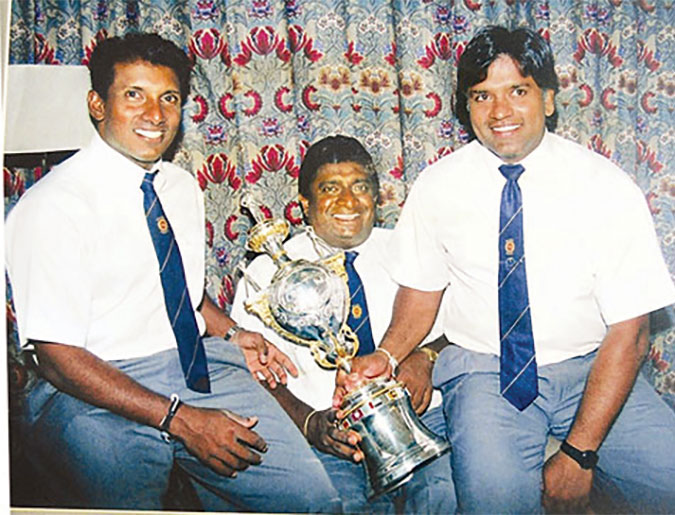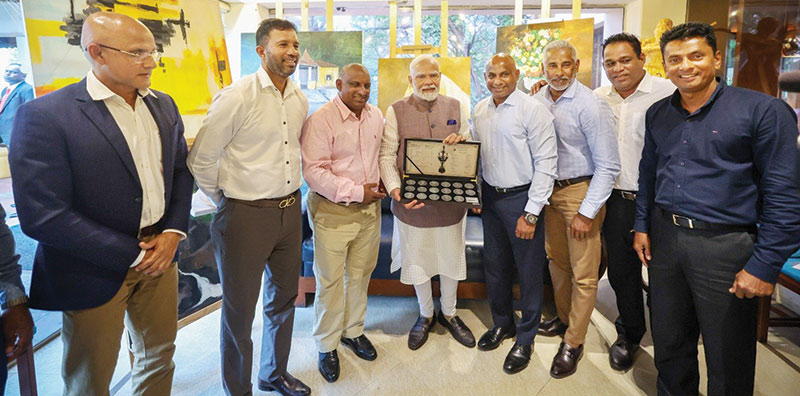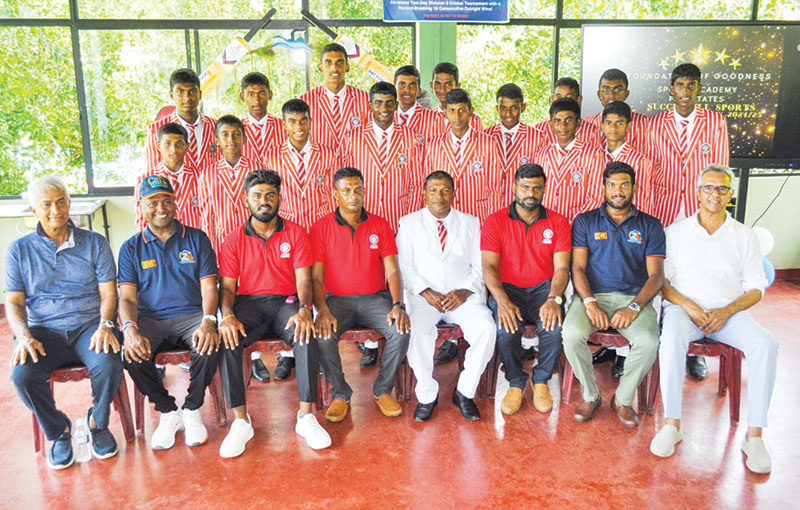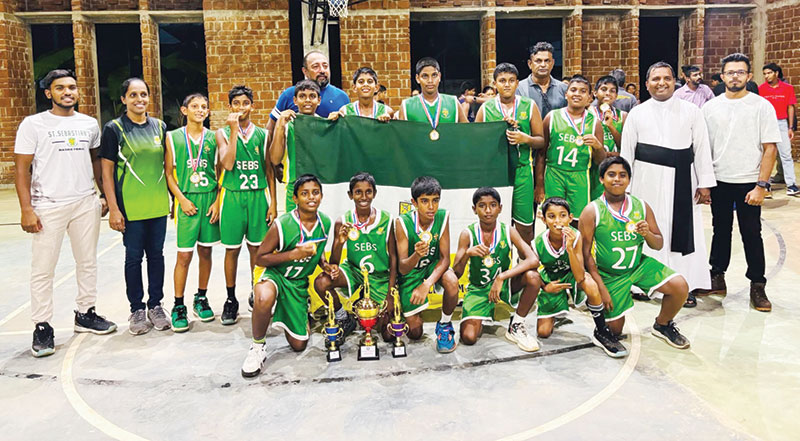Sports
Dulla’s insatiable appetite for excellence

by Rex Clementine
Most cricketers reaching 70 these days prefer the comforts of their homes, their holiday spots or spending time with their kids looking after their grandchildren. Even before reaching 70, Ian Botham is tasting wine and relaxing in Ravensworth in Yorkshire. Viv Richards is in Antigua sipping rum while Imran Khan is contemplating his political future. They have got nothing to do with cricket and even the other septuagenarians who have some interest in cricket like Sunil Gavaskar or Michael Holding, they prefer the air conditioned comforts of the commentary box. Only those who have the insatiable appetite for excellence in cricket take up coaching at the age of 70. They are a different breed. Duleep Mendis belongs to that category. In fact when it comes to cricket, he’s a different beast. He leaves nothing for chance, isn’t afraid to tread on the roads less travelled and moves about with a single-mindedness as if history is there to be created.
Duleep’s association with Oman cricket had not only seen the emergence of a new regional powerhouse of the sport but a cricketing nation that’s ever improving and increasing its stakes in big events. From a little known entity in world cricket, under Duleep, Oman have gone onto receive T20 and ODI International status. The country also had qualified for the ICC T20 World Cup and earlier this week reached the qualifiers of this year’s 50 overs World Cup which will be played in Zimbabwe.
Cricket has been Duleep’s life and in the last 50 years he has been in the limelight first as a player, having played a pivotal role in Sri Lanka’s journey to Test status and then skippered the nation for their inaugural Test win. Post playing career he dedicated another 20 years for the game as coach, manager and Chairman of Selectors and his contributions were vital during every milestone of our cricket.
A lot of people think that what makes Dulla special is his ability to put people in their places. While that maybe true, his speciality is his ability to read the game. He is also not afraid to make tough decisions and his single-mindedness has often helped Sri Lankan teams to come out of tricky situations.
The Sri Lankan team benefited immensely during his direct involvement with the them for two decades and it is these expertise that is helping Oman currently on their march towards being a strong cricket force. What Duleep has achieved in such a short span has marveled everyone for Arabs are not much into cricket in Oman and it’s the Indian and Pakistani communities employed in Oman that is keeping cricket at a good standard.
Duleep during his Sri Lanka days was at one point dragged out of the national team and was handed bigger responsibilities. As Director Cricket Operations he took the game to grassroots and currently if outstations are feeding more players to the national team than established centers like Colombo, Kandy and Galle it is due to Duleep’s visionary thinking in putting up practice facilities, providing turf wickets and investing on provincial and district coaches.
It is as CEO, Duleep dazzled most. That he was the head of the board never occurred to him. He mingled with all employees of the board without maintaining distance and that’s why he’s popular even to this date. That doesn’t mean that he tried to please everyone. Sometimes he warned his elected bosses of consequences of certain ill advised decisions. He was firm during certain pay disputes and encouraged mechanisms to look after retired players although they never bore fruit due to some men with vested interests. Duleep could be ruthless when it came to negotiations. The South Africans were in town in 2006 and were hammered in the Test series. This was the same series where Sanga and MJ put on the World Record partnership. A few days later there was a bomb blast half a kilometer from the team hotel and the South Africans wanted to go home without playing the limited overs leg.
The CEO, the Board President and the IGP Chandra Fernando met the South African team management at the Cinnamon Grand. Even after being offered security provided to heads of states, the tourists didn’t change their stance. They wanted to go home. Duleep warned the South Africans of dire consequences. With the series called off, the press asked the Board President for a comment. He played it down diplomatically. But Duleep didn’t mince his words. He said, ‘I have a headline for you.’ So what was the headline ‘Proteas chicken-out’.
Sports
Lankan legends, Modi and the Jaffna dream

Tamil Members of Parliament with roots across the Palk Strait are often quick to look towards India at the drop of a hat. But last week, all they managed was a photo op with Indian Prime Minister Narendra Modi – smiles, handshakes and little else. In contrast, Sri Lanka’s 1996 World Cup-winning cricket team was granted a 45-minute chinwag over tea with the Indian leader. The Indian High Commission in Colombo had arranged the meeting. Not even former President Ranil Wickremesinghe, with all his so-called diplomatic finesse, has managed to get a similar audience.
Pictures of Modi rubbing shoulders with Sanath Jayasuriya and Aravinda de Silva went viral in India on social media and it was the talking point across news channels and print media as well. And why not? Not since the marauding days of Sir Vivian Richards have Indian bowlers been sent on a leather hunt quite like they were by these two Sri Lankan giants. It was déjà vu for Indian fans – memories of the Wills World Cup semi-final at Eden Gardens, still fresh like an old wound that refuses to heal.
During the meeting, Jayasuriya pitched an idea to the Indian PM – seeking help to build a cricket stadium in Jaffna. It wasn’t a doosra out of nowhere. There’s a deep and genuine passion for cricket in the north. Some of the school big matches in the region have stood the test of time, with legacies stretching back over a century. Yet, due to decades of conflict, the region has remained a barren patch in terms of producing top-tier cricketing talent.
Since the guns fell silent, though, there’s been a fresh crop of hopefuls from the north. Leading the charge is leg-spinner Vijayakanth Viyaskanth – a name that’s now turning heads. Though his First-Class stats are more than decent, Viyaskanth has chosen the glitz and glamour of franchise cricket, where the pay cheques are fatter and the schedule less grueling.
Behind the scenes, Sri Lanka Cricket’s (SLC) District and Provincial coaches have done a stellar job, scouting and grooming pace bowlers and other youngsters from these long-neglected areas. Some of these boys have gone on to wear the Under-19 jersey with pride – a sign that the talent pool is slowly, but surely, filling up.
However, SLC’s grand vision of building new stadiums to attract larger crowds has hit a few bumps. The old guard – some former greats – have been quick to swing the bat in criticism. They’ve taken their eye off the ball, failing to see the bigger picture. Take next year’s T20 World Cup, for instance. Co-hosted by Sri Lanka and India, it promises to be a blockbuster. The high-voltage India – Pakistan clash is set to take place in Colombo, with the R. Premadasa Stadium’s 35,000 seats expected to vanish like isso vade at the Galle Face green. A bigger venue – like the proposed facility in Homagama – would have been just the ticket to meet such mammoth demand.
But Sanath’s plea is in a different league altogether. He’s not asking for a behemoth like Eden Gardens or the Narendra Modi Stadium in Ahmedabad. His is a humble request – a ground with decent infrastructure and floodlights that can host day-night matches. A facility like that would be a game-changer for the north, a true shot in the arm. Nothing ignites a young cricketer’s imagination more than watching their heroes up close, not through a television screen but under the stars, in their own backyard.
At present, the closest international venue to Jaffna is in Dambulla—hardly accessible, especially for aspiring fans and players from the peninsula. A ground in Jaffna would not only bridge that distance but also build a bridge of hope and opportunity.
Back in 2002, when Janashakthi opened a branch in Jaffna, the great Muttiah Muralitharan made the long road trip to play a friendly match on a matting wicket. The welcome he received was nothing short of electric. The crowd adored him, showering him with affection that could rival the warmth of any southern stand.
Since then, we’ve hardly scratched the surface when it comes to understanding the region’s cricketing appetite. If the Indian government lends an ear to Sanath’s appeal, we might just discover a goldmine of talent waiting to be unearthed in the north. Who knows? The next Murali or Malinga might be bowling on a dusty street in Jaffna this very moment – waiting for a stage, a spotlight, and a bit of help from across the Palk Strait.
by Rex Clementine
Sports
Sri Sumangala’s cricketing miracle

Sri Sumangala Vidyalaya, Hikkaduwa has scripted a fairytale rise in school cricket, marking a monumental milestone just 18 years after forming its first team. Once deprived of even a proper ground, the school now proudly boasts an unbeaten Under-19 team that has clinched both the Division III two-day and one-day championships — a rare double that has earned them promotion to Division 2.
The turnaround began in 2007 when the Marylebone Cricket Club (MCC) helped establish the Sri Sumangala MCC Lord’s Cricket Grounds following the devastating tsunami. This facility, offered free of charge, became a beacon for young cricketers who had talent but lacked opportunity. What followed is nothing short of a sporting miracle: 16 consecutive outright wins by the U19 team and national recognition in school cricket circuits.
This isn’t just a story of trophies and titles — it’s about breaking generational barriers. These young cricketers, once trapped in a cycle of poverty and obscurity, now inspire their community and set benchmarks for others in rural Sri Lanka.
The MCC’s early investment has borne fruit, turning dreams into tangible success. Today, the legacy of Lord’s lives not only in London but also in the hearts of the aspiring cricketers of Hikkaduwa — proof that when given a chance, talent can indeed take flight.
Foundation of Goodness has been a beacon of hope for sporting talents in the region and representation for Sri Lanka Women’s Under-19 team has been dominated by them. The same could happen with the men’s team in the near future.
Sports
St. Sebastian’s back on the basketball track

In the bygone years it was the Colombo schools that dominated basketball in Sri Lanka. Bens under Ram Sunderalingam, Peterites coached by Naufer Mahroof and the Josephians shaped by Mahadevan were the trojans who won tournaments. Led by this trio and flanked by other basketball playing schools in the capital, the game had its foundation laid down in concrete – Colombo style.
Moratuwa and Batticaloa were the painful thorns amidst the Colombo teams when it came to championships. And Trinco was the dark horse, almost unbeatable in their heyday, playing under the wizard, late Father Eugene Herbert. This is what basketball was, beginning from the sixties.
Today the faded memories remain. On a lucky day one might meet Doc Thurai, as he was popularly known, walking his wards with the stethoscope round his neck. He was the best we saw in that era. If one visits Batticaloa there is a prominent statue outside the town. It is of a tall Jesuit Priest. Here, he cradles a Wilson basketball ready to take a ‘time-out’ and yell at the referee. That is Father Herbert, the man who filled the Eastern Province with stellar players who left their luminous mark in the basketball courts of Sri Lanka.
More recently in April, on the 6th Sunday, I watched the under 13 ‘B’ division basketball finals between St. Sebastian’s and St. Thomas’ Prep. It was played at a flood-lit indoor court in Moratuwa. No, it certainly wasn’t in the league of Madison Square Garden, but it was more than adequate for a schools’ final. I sat on a wooden bench and watched the match thanking the court creator Sugath Thevarapperuma. I must mention this former national player who is doing yeomen service to promote basketball by establishing indoor courts in different locations.
Back to the match. It was good and exciting and the Sebastians won 37-36 by a solitary point. This was great for Moratuwa and the school and the young players. This victory would awaken the school and the basketballers from the doldrums they had been mired for a considerable time to say ;we are coming back’.
This 1-point victory I witnessed appeared to me as a catalyst for greater performances and perhaps an eye-opener for the Moratuwa lads. They are indeed capable of leaping bigger steps to reach higher pedestals in schools’ basketball championships. Yes, that is an achievable possibility, and the need is to change gears and go for the over-drive.
It is time for St Sebastian’s to forget the apathetic era and the reasons for such, and forge ahead with renewed motivation to re-claim former glories with their current potential.
The Thomians fought to the end. They certainly were equal in spirit and determination to become the champions. The difference was simply 1 solitary point. The pattern of play was the same by both teams and the award for the best player went to Akash Wijesinghe and Amantha Hettiarachchi was adjudged the best guard.
I noticed that some new rules have been introduced to control the game. The teams are only allowed to play ‘man-to-man’ and they could do so only from the center line. Additionally, the coach cannot use a double guard on the opposing best player. The teams are not allowed to use a zonal defense or play a floating man to man. If these rules came from FIBA then there is no argument. But if it is a local ramification of rules of how the game should be played, I have to humbly say that this will be a significant deterrent to coaches and players and a recurring headache to the referees. Over to you Sir, the Head of the Schools’ Basketball Association.
For me personally, it was an ‘Alma Mater delight’ to notice that the two coaches of the playing teams were both from St Sebastians and the assistant coach too was from my old school. Chaminda de Alwis and Susil Dias coached St. Sebastian’s and Isuru Perera the Thomians.
Chaminda captained the national team and Isuru had Ceylon Basketball colours and Susil represented All Island Schools.
Yes, St. Sebastian’s had a lot of glory days in basketball. Many of their players represented and captained the national team. Then one might ask, “how come they hit rock bottom playing a game they more or less dominated?”
The answer is simple, I will leave it for another day to elaborate.
On second thoughts, some things are best left unsaid.
by Capt. Elmo Jayawardena
elmojay1@gmail.com
-

 Business6 days ago
Business6 days agoColombo Coffee wins coveted management awards
-

 News1 day ago
News1 day agoSuspect injured in police shooting hospitalised
-

 Features2 days ago
Features2 days agoRobbers and Wreckers
-

 Features4 days ago
Features4 days agoSri Lanka’s Foreign Policy amid Geopolitical Transformations: 1990-2024 – Part III
-

 Midweek Review4 days ago
Midweek Review4 days agoInequality is killing the Middle Class
-

 Features6 days ago
Features6 days agoSri Lanka’s Foreign Policy amid Geopolitical Transformations: 1990-2024 – Part I
-

 Features5 days ago
Features5 days agoA brighter future …
-

 Business1 day ago
Business1 day agoSanjiv Hulugalle appointed CEO and General Manager of Cinnamon Life at City of Dreams Sri Lanka












